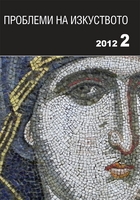Забравената църква „Св. Йоан Богослов” в Созопол
The Obliterated Church of St. John the Theologian in Sozopol
Author(s): Ivan VanevSubject(s): Cultural history
Published by: Институт за изследване на изкуствата, Българска академия на науките
Summary/Abstract: The Church of St. John the Theologian in Sozopol, dated to the late eighteenth century, has most probably been built on the foundations of an earlier one. In the early twentieth century it has been home to a rich collection of invaluable icons of the fourteenth to nineteenth century. During the wars for national reunion, the church has been left derelict and in the early 1960s was demolished despite some attempts to be preserved. So the Church of St. John the Theologian remained an unexplored site, consequently forsaken by researchers. Talks of the demolished church started only recently with the increasing interest in the historical heritage of Sozopol and the intensive archaeological explorations within the territory of the town. The facts revealed in this survey allow for clarifying a number of problems related to the design of the church, showing a number of inaccuracies in its building plan, published in 1977. A few photos of the altar murals were found in the archives of the National Institute for Immovable Cultural Heritage, which were known only from early publications. This study follows the where abouts of the icons following the demolition of the church. Over the years, these have been part of different collections and imprecise information of their provenance has occurred in scientific literature. Old photos and documents from different archives across the country have been used to identify the icons from the Deesis tier. Now the icons of the Church of St. John the Theologian are part of the holdings of the National Church Museum of History and Archaeology; of the Museum of Archaeology, Sozopol and of the Art Gallery in Burgas. The icon of the patron saint was identified and dated to the fourth quarter of the fourteenth century, been acquired by a private collector after being taken from the church.
Journal: Проблеми на изкуството
- Issue Year: 2012
- Issue No: 2
- Page Range: 27-35
- Page Count: 9
- Language: Bulgarian
- Content File-PDF

